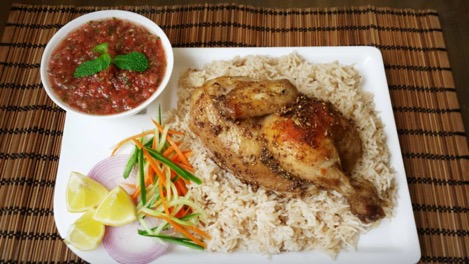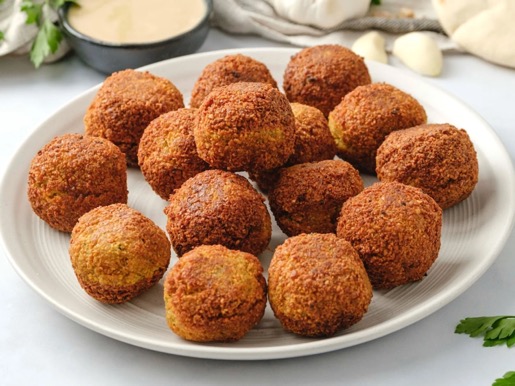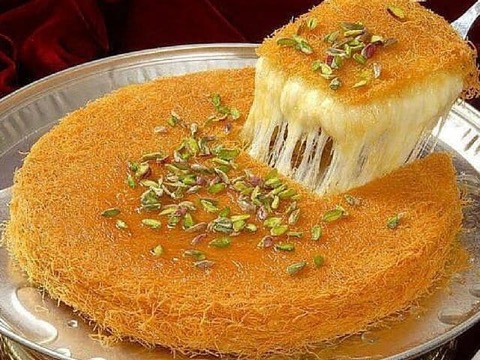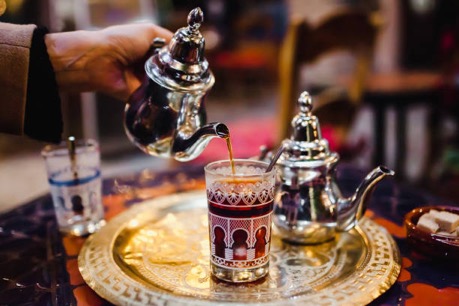A Flavorful Journey into the Heart of Saudi Arabian Cuisine
Saudi Arabian cuisine is a culinary delight that embodies the rich history, cultural diversity, and geographical influences of the region. This Middle Eastern cuisine is known for its bold flavors, aromatic spices, and hearty dishes that have been passed down through generations.
The cuisine of Saudi Arabia is deeply rooted in Bedouin traditions, Islamic customs, and the nomadic lifestyle of its people.
Saudi Arabia's culinary heritage is a tapestry woven with the threads of ancient civilizations, trade routes, and cultural exchanges. Being a crossroads between Asia, Africa, and Europe, Saudi Arabia has absorbed culinary influences from various cultures, resulting in a diverse and vibrant food scene.
The Bedouin nomads, with their resourcefulness in utilizing local ingredients, laid the foundation of Saudi Arabian cuisine. Their diet mainly consisted of milk, dates, and meat, which were easily available in the arid desert landscape. Over time, Saudi Arabian cuisine evolved to incorporate spices, herbs, and cooking techniques from neighboring regions such as Persia, India, and the Levant.
Moreover, Saudi Arabia's historical position as a hub of the incense and spice trade brought an array of exotic ingredients that further enriched the local cuisine. From cardamom and saffron to cinnamon and cloves, these spices became integral to the distinctive flavors that define Saudi Arabian dishes.
Today, Saudi Arabian cuisine is cherished for its authenticity and the pride with which it is prepared and shared. Whether it's a grand feast during festivities or a simple meal with family and friends, Saudi Arabian cuisine reflects the warmth, hospitality, and deep-rooted traditions of the Saudi people.
As we delve into the top 15 must-try Saudi Arabian foods, we will uncover the tantalizing flavors, unique cooking methods, and cultural significance behind each dish. From aromatic rice-based specialties to flavorful street food and delectable desserts, the culinary journey through Saudi Arabia promises to be a feast for the senses. So, let's embark on this delicious exploration and savor the flavors of Saudi Arabia!
Traditional Saudi Arabian Dishes
Kabsa

Kabsa, often hailed as the national dish of Saudi Arabia, is a flavorful and aromatic rice-based dish that holds a prominent place in Saudi Arabian cuisine. It is a culinary masterpiece that perfectly blends fragrant spices, tender meat, and long-grain rice, creating a symphony of flavors on the palate.
Kabsa typically consists of spiced rice, tender pieces of meat (such as chicken, lamb, or goat), and a medley of vegetables. The dish is characterized by its vibrant yellow color, which comes from the generous use of saffron. Fragrant spices like cardamom, cinnamon, cloves, and black lime (loomi) infuse the rice and meat with their distinct flavors.
The preparation of Kabsa involves slow-cooking the meat to ensure it is tender and succulent. The rice is cooked separately with spices and then layered with the meat and vegetables to allow the flavors to meld together. The resulting dish is a harmony of textures, aromas, and tastes that are a true delight for the senses.
Kabsa holds immense cultural significance in Saudi Arabian cuisine. It is a dish that brings families and communities together, often served during festive occasions and gatherings. Sharing a steaming plate of Kabsa is a symbol of hospitality, generosity, and camaraderie.
While Kabsa is beloved throughout Saudi Arabia, it is worth noting that there are regional variations that add diversity to the dish. In the southern region of Asir, Kabsa is traditionally made with a type of rice called "biryani rice," which has a slightly different texture and flavor. In the eastern province of Al-Ahsa, Kabsa may feature a generous amount of nuts and dried fruits, giving it a delightful sweetness.
In essence, Kabsa represents the heart and soul of Saudi Arabian cuisine. It encapsulates the rich flavors, cultural heritage, and communal spirit that make Saudi Arabian food truly exceptional. So, when you visit Saudi Arabia, be sure to indulge in a plate of fragrant Kabsa and experience the true essence of this remarkable cuisine.
Shawarma
Shawarma, a beloved street food in Saudi Arabian cuisine, is a mouthwatering dish that traces its origins back to the Middle East. The word "shawarma" comes from the Turkish term "çevirme," meaning "turning" or "rotating," referring to the cooking method used for this delectable delicacy.
Traditionally, shawarma consists of marinated slices of meat, such as beef, lamb, or chicken, stacked on a vertical spit and slowly roasted as it rotates, allowing the meat to cook evenly and develop a succulent texture. The layers of meat are thinly sliced, resulting in tender and flavorful strips of meat that are packed with savory goodness.
In Saudi Arabia, shawarma holds a special place in the hearts and taste buds of locals and visitors alike. The country offers a variety of shawarma options, reflecting the diversity of Saudi Arabian cuisine. One popular variation is chicken shawarma, where marinated chicken is thinly sliced and piled into a warm pita bread or flatbread. Beef shawarma, with its robust flavor, is also widely enjoyed. Additionally, lamb shawarma, known for its tender and juicy meat, is a favorite among meat lovers.
The combination of tender, seasoned meat, flavorful toppings, and tantalizing sauces creates a harmonious and satisfying eating experience. Whether enjoyed as a quick street food snack or as a fulfilling meal, shawarma showcases the culinary prowess of Saudi Arabian cuisine.
Mandi

Mandi is a traditional Saudi Arabian dish that consists of tender, slow-cooked meat (usually lamb or chicken) served on a bed of fragrant long-grain rice. The dish is prepared by marinating the meat in a blend of aromatic spices, such as cardamom, cloves, cinnamon, and black lime (loomi). The meat is then cooked in a tandoor (a traditional clay oven) or a large underground pit, allowing it to slowly roast and absorb the smoky flavors.
The rice is an essential component of mandi and is cooked separately with spices, including saffron, turmeric, and bay leaves, to infuse it with a vibrant color and enticing aroma. The rice is steamed until fluffy and tender, providing a perfect base for the flavorful meat.
Mandi has several popular variations, each with its own unique flavors and regional influences. One popular variation is called "Madfoon," where the meat is first marinated and then wrapped in banana leaves or aluminum foil before being slow-cooked. This method helps to lock in the moisture and intensify the flavors.
Another variation is "Mathbi," where the marinated meat is grilled or roasted over an open flame, giving it a slightly charred and smoky taste. The cooking method for Mathbi adds a distinct flavor profile to the dish.
Mandi is typically served with a variety of accompaniments that enhance the dining experience. These can include a selection of tangy and spicy sauces, such as tomato-based sauces or chili sauces, which add a burst of flavor to the succulent meat and fragrant rice. Additionally, a side of mixed vegetable salad, known as "Salata Hara," is often served alongside Mandi to provide a refreshing contrast to the rich and savory flavors.
Traditionally, Mandi is served communally, with a large platter placed in the center of the dining table. Diners gather around the platter and use their hands to savor the dish, taking portions of meat and rice and combining them with the accompanying sauces and salads. This communal style of serving highlights the social aspect of enjoying Mandi, as it encourages interaction and shared enjoyment of the meal.
Mandi is not only a delicious dish but also represents the cultural heritage and traditions of Saudi Arabian cuisine. Its aromatic flavors, tender meat, and fragrant rice make it a must-try dish for anyone seeking an authentic culinary experience in Saudi Arabia.
Mutabbaq
Mutabbaq, a popular savory pastry in Saudi Arabian cuisine, is a delightful treat that showcases the culinary creativity and flavors of the region. The word "mutabbaq" means "folded" in Arabic, referring to the folded shape of this delectable snack.
The pastry of mutabbaq is made from thin layers of dough, which are carefully folded and filled with a variety of savory ingredients. The dough is typically made with flour, water, oil, and a pinch of salt, resulting in a thin and crispy outer layer. The filling options for mutabbaq are abundant and diverse, ranging from minced meat (such as beef or chicken) to vegetables (such as onions, peppers, and spinach). Spices and herbs like cumin, coriander, and turmeric are often used to enhance the flavor profile of the filling.
In Saudi Arabian cuisine, mutabbaq exhibits regional variations in terms of fillings and flavors. Different areas within Saudi Arabia have their own unique twists on this beloved street food. For example, in the city of Jeddah, seafood mutabbaq is a popular variation, where the filling consists of a delectable mix of shrimp, fish, or crab, complemented by aromatic spices.
Mutabbaq holds significant importance in Saudi Arabian street food culture. It is commonly found in street food markets, local eateries, and food stalls throughout the country. The accessibility and portability of mutabbaq make it a convenient and delicious option for people on the go.
Jareesh
Jareesh is a traditional Saudi Arabian dish that holds a special place in the country's culinary heritage. It is a hearty porridge-like dish made from cracked wheat, which undergoes a unique fermentation process to develop its distinct flavors and textures.
The process of making jareesh involves soaking the cracked wheat in water for several days, allowing it to ferment naturally. This fermentation process softens the wheat grains and imparts a tangy, slightly sour taste to the dish. The softened wheat is then cooked with water or broth until it reaches a creamy consistency.
In Saudi Arabian cuisine, jareesh is traditionally prepared using a large wooden mortar and pestle called a "jareeshah." The soaked and softened wheat is placed in the jareeshah and pounded using the pestle until it forms a smooth and creamy texture. This traditional method not only breaks down the wheat grains but also enhances the flavors and creates a unique texture.
Popular Street Foods
Falafel

Falafel is a beloved Middle Eastern street food that has gained popularity worldwide, including in Saudi Arabian cuisine. These crispy and flavorful deep-fried balls are made from ground chickpeas or fava beans, mixed with herbs, spices, and onions. Falafel is known for its satisfying texture, earthy flavors, and versatility.
When enjoying falafel in Saudi Arabian cuisine, it is typically served in warm pita bread, creating a pocket of flavors and textures. The pita is stuffed with falafel balls and accompanied by an array of condiments and toppings. Common additions include tahini sauce, garlic sauce, pickles, tomatoes, cucumbers, lettuce, and parsley. These condiments add tanginess, creaminess, and freshness to the dish, enhancing the overall experience.
Samboosa
Samboosa, also known as samosa, is a popular street food found not only in Saudi Arabian cuisine but throughout the Indian subcontinent, the Middle East, and beyond. It is a triangular pastry filled with a savory mixture of spiced vegetables, meat, or both. The outer shell is made from thin dough, which is folded into a distinctive shape and deep-fried until golden and crispy.
One of the highlights of samboosa is the variety of fillings and flavors it offers. In Saudi Arabia, samboosa fillings can range from spiced minced meat (such as chicken, beef, or lamb) to a vegetarian mixture of potatoes, peas, onions, and aromatic spices. The fillings are often seasoned with a blend of spices like cumin, coriander, turmeric, and chili powder, which infuse the samboosa with a delicious and fragrant taste.
Mutabbaq as a street food
Mutabbaq, which was earlier discussed as a traditional Saudi Arabian dish, also finds its place as a popular street food. In its street food form, mutabbaq is typically smaller and handheld, making it easy to enjoy on the go. The dough is filled with a savory filling, often featuring minced meat, onions, and a blend of aromatic spices. The filled dough is then folded and either deep-fried or cooked on a griddle until golden and crispy.
In Saudi Arabia, you can find mutabbaq vendors in bustling street markets, food stalls, and dedicated mutabbaq shops. Cities like Riyadh, Jeddah, and Dammam have renowned mutabbaq vendors who have perfected their recipes and cooking techniques over generations. Some famous locations include Mutabbaq Al-Musa in Riyadh and Mutabbaq Abu Zaid in Jeddah.
READ MORE:
Using the website of the Online Saudi Arabia, you may rapidly apply for a Saudi Arabia e-Visa. The procedure is easy and uncomplicated. You may finish the Saudi Arabia e-visa application in only 5 minutes. Go to the website, click "Apply Online," and adhere to the instructions. Learn more at Complete Guide to Saudi Arabia e-Visa.
Desserts and Sweets
Kunafa

Kunafa is a beloved dessert in Saudi Arabian cuisine that tantalizes the taste buds with its combination of textures and flavors. It consists of shredded phyllo dough, also known as kataifi, layered with a creamy filling and soaked in a sweet syrup. The filling is traditionally made with a blend of cheese, such as akkawi or mozzarella, which provides a rich and savory contrast to the sweetness of the syrup.
Kunafa showcases regional variations and specialties within Saudi Arabian cuisine. In the city of Jeddah, for example, a popular variation is kunafa with cream, where the cheese filling is replaced with a luscious cream filling. Other regional specialties may include the addition of nuts, such as pistachios or almonds, to enhance the texture and add a delightful crunch.
Kunafa is typically served warm or at room temperature, allowing the flavors to meld together. It is often garnished with a sprinkling of ground pistachios or a drizzle of rose or orange blossom water for added fragrance. To complement the sweetness of kunafa, it is common to enjoy it with a cup of Arabic tea or a glass of refreshing mint lemonade.
Basbousa
Basbousa is a popular semolina cake that is widely enjoyed as a dessert in Saudi Arabian cuisine. It is made from a mixture of semolina, sugar, yogurt, and sometimes coconut, creating a dense and moist cake. The syrup plays a crucial role in basbousa, as it is poured over the cake after baking, allowing it to soak in and infuse the dessert with a delightful sweetness.
Basbousa offers a range of flavors and textures. The semolina gives it a slightly grainy texture, while the addition of yogurt provides a tangy note. Variations of basbousa can include the incorporation of ingredients like nuts (such as almonds or walnuts) or flavored syrups (such as rosewater or orange blossom water), adding layers of complexity to the dessert.
Basbousa is commonly enjoyed during festive occasions, family gatherings, and religious holidays in Saudi Arabia. It is often served alongside other traditional sweets and desserts, creating a delectable spread for guests to enjoy. Basbousa's sweet and comforting flavors make it a delightful treat to savor with a cup of aromatic Arabic coffee or tea.
Dates and Arabic Coffee
Dates hold immense cultural significance in Saudi Arabian cuisine and traditions. They are considered a staple food and a symbol of hospitality. Dates have been consumed for centuries in the Arabian Peninsula due to their nutritional value and ability to thrive in the desert environment. They are often served as a gesture of welcome to guests and are a common offering during religious occasions and social gatherings.
Arabic coffee, also known as "qahwa," is an integral part of Saudi Arabian culture and is often served alongside dates. It is a lightly roasted and finely ground coffee that is traditionally prepared in a "dallah," a long-spouted coffee pot. The preparation involves a meticulous brewing process, which includes simmering the coffee with cardamom and sometimes other spices, creating a unique and aromatic flavor profile.
In Saudi Arabian culture, serving dates and Arabic coffee is accompanied by specific traditions and etiquette. The host often presents a tray of fresh dates to guests, who are expected to accept them graciously as a sign of respect. The dates are typically enjoyed before partaking in the Arabic coffee, which is served in small cups called "finjans." It is customary to hold the finjan with the right hand while sipping the coffee slowly, engaging in conversation and enjoying the warmth and flavors.
Beverages
Saudi Arabian Tea

Saudi Arabian tea, also known as "shai," is a popular and aromatic beverage enjoyed throughout the country. It is typically made from black tea leaves and infused with aromatic spices such as cardamom, cloves, and cinnamon. The tea is brewed to perfection, creating a flavorful and fragrant drink that is often enjoyed hot.
While traditional Saudi Arabian tea is often enjoyed plain or with a hint of spices, it is not uncommon to find variations with additional flavorings and additions. Some popular additions include fresh mint leaves, saffron, or rosewater, which enhance the aroma and provide a refreshing twist to the tea.
Saudi Arabian tea holds cultural importance as a symbol of hospitality and warmth. It is customary for guests to be offered a cup of tea upon arrival, which serves as a gesture of welcome and hospitality. The tea is typically served in small glasses or cups, and it is common for guests to hold the cup with the right hand as a sign of respect. Saudi Arabian tea is often enjoyed during social gatherings, family visits, and business meetings, fostering a sense of community and connection.
Laban
Laban is a traditional yogurt-based drink that is popular in Saudi Arabian cuisine. It is made by fermenting yogurt with water, resulting in a refreshing and tangy beverage. Laban is known for its smooth and creamy texture, which provides a cooling effect and makes it a popular choice during hot weather.
Laban can be enjoyed in different variations and flavors to suit individual preferences. Some variations include laban ayran, which is a salted yogurt drink, and laban zeer, which is made by fermenting yogurt for an extended period, resulting in a tangier taste. Laban can also be flavored with additions such as mint, cucumber, or a touch of spices like cumin or black pepper, adding depth and complexity to the drink.
Laban is not only a refreshing beverage but also offers several health benefits. It is rich in probiotics, which promote a healthy gut and aid digestion. Laban is also a good source of calcium, protein, and vitamins, making it a nutritious choice for hydration.
Conclusion
In this culinary exploration of Saudi Arabian cuisine, we have delved into a diverse range of dishes, street foods, desserts, and beverages. From the flavorful Kabsa and Mandi to the mouthwatering Mutabbaq and Kunafa, Saudi Arabian cuisine offers a plethora of delicious and culturally significant culinary experiences.
Saudi Arabian cuisine is a reflection of the country's rich heritage and the fusion of flavors influenced by its geographical location and historical trade routes. We encourage you to embark on a culinary adventure, exploring local restaurants, street markets, and traditional homes to discover the hidden gems and unique flavors that Saudi Arabia has to offer.
Food holds deep cultural significance in Saudi Arabian society. It not only nourishes the body but also brings people together, symbolizing hospitality, generosity, and unity. From the communal sharing of dishes to the traditional customs surrounding tea and dates, food plays a central role in social gatherings, celebrations, and daily life.
As you immerse yourself in the flavors of Saudi Arabian cuisine, remember to savor not only the delicious tastes but also the cultural stories and traditions that accompany each dish.
READ MORE:
Saudi Arabia's rich cultural heritage is beautifully showcased through its historical sites and cultural landscapes. From the pre-Islamic period to the Islamic era, and from coastal regions to mountainous landscapes, the country offers a diverse range of attractions for tourists to explore and appreciate. Learn more at Tourist Guide to Historical Sites in Saudi Arabia.
Check your eligibility for Online Saudi Visa and apply for Online Saudi Visa 72 hours in advance of your flight. Australian citizens and French citizens can apply online for Online Saudi Visa.